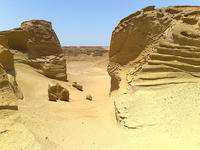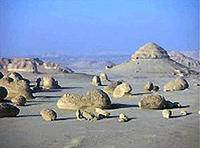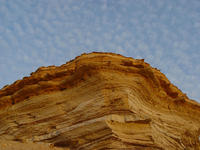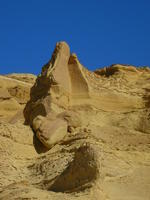You are in: Africa -> Egypt -> Wadi Al-Hitan (Whale... , and traditional search or Image Gallery will yield results of this site only
Wadi Al-Hitan (Whale Valley)
| Site number: | 1186 |
|
| Type of site: | Natural | |
| Date of Inscription: | 2005 | |
| Location: | Africa, Egypt, Faiyum Governorate | |
Up to 75 images are shown here. Click on each for more details or on Image Gallery for more images.
| Description: | Situated in the Western Desert of Egypt, Wadi Al-Hitan (Whale Valley) holds priceless fossil remains of the earliest suborder of whales, the archaeoceti, who are now extinct. These fossils illustrate one of evolution’s major components: the origin of whales as land-based animals who adapted to life in the ocean. In terms of demonstrating this stage of evolution, findings in Wadi Al-Hitan have proven to be the most important in the world, as they vividly portray the whales’ life and form during their transition. This collection of fossils’ is unique in its amount, concentration and quality, as well as its accessibility and setting in a striking and protected landscape. The fossils of Al-Hitan are evidence for the youngest archaeocetes during the final stages of losing their hind limbs. Whilst maintaining certain primitive aspects of skull and tooth structure, they already demonstrate the distinctive streamlined body form of modern whales. With the help of other fossil material around the site, it has been possible to reconstruct the contiguous environmental and ecological conditions of the time. --WHMNet paraphrase from the description at WHC Site, where additional information is available. | |
| Wadi Al-Hitan (Arabic: وادي الحيتان, Whale Valley) is a palaeontological site in the Al Fayyum Governorate of Egypt. It was designated a UNESCO World Heritage Site in July 2005 for its hundreds of fossils of some of the earliest whale forms, the archaeoceti. The fossils show remnants of hind limbs, recording the evolution of whales from land-dwellers to ocean-dwellers. The Egyptian government has alleged that in July 2007 a pair of cars driven by Belgian diplomats entered a protected zone in this area, and caused $325,000 US worth of damage. The Belgium government has said no damage was caused by its diplomats. The issue remains unresolved. --Wikipedia. Text is available under the Creative Commons Attribution-ShareAlike License. | ||
| Source: | http://whc.unesco.org/en/list/1186 | |
| Reference: | 1. UNESCO World Heritage Center, Site Page. | |

























